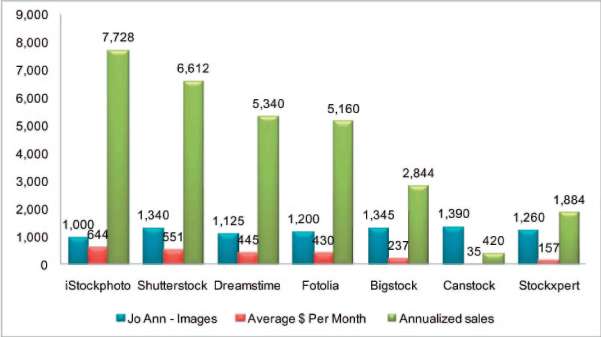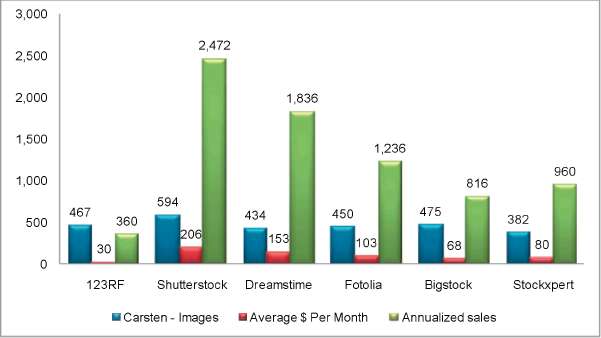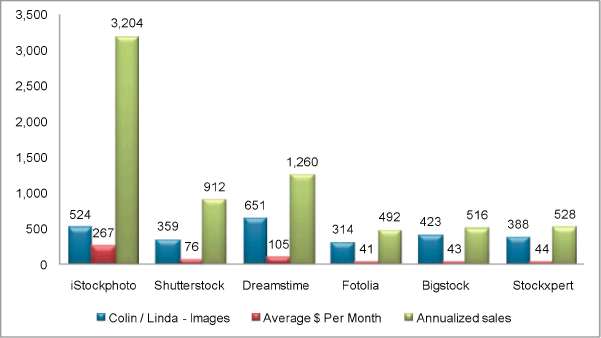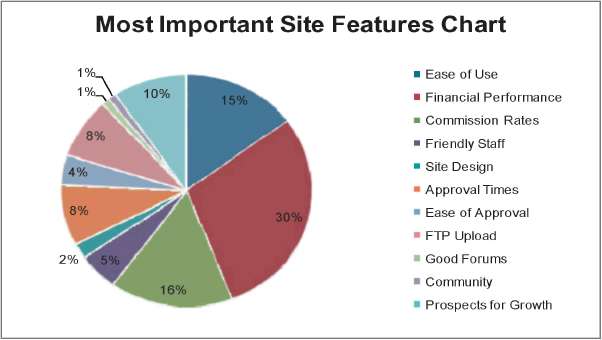CHAPTER 10
Case Studies
In the course of preparing this book, I asked a number of microstock contributing photographers to volunteer to outline their microstock experiences and provide me with some numbers. The statistics and responses presented here are from the end of 2006, and the figures will no doubt have changed since they were compiled (e.g., anecdotal evidence suggests that Fotolia is improving and iStockphoto is giving some ground to the newer competition). Nonetheless, they provide an interesting snapshot of the microstock market as it matures and expands. Their additional comments were also fascinating, and I have taken some of the more relevant figures and comments and detail them below.
Some of our top contributors are making between $100,000 [and] $300,000 a year. That's a lot of “cents.” Many are paying their mortgages, putting the kids through school, buying cars, etc. Others are making a nice supplemental income.
Bruce Livingstone, CEO, iStockphoto
Bear in mind that a number of factors influence financial performance. For example, if a photographer has just uploaded a large number of images, then his or her average monthly earnings for that library or libraries may appear to be diluted. Obviously other factors also affect the figures, such as the types of images uploaded. As the microstocks evolve, their relative performance can also change quite radically. Alterations to search engines may benefit some photographers at the expense of others, as can site redesigns, new advertising campaigns, and so on.
STEPHEN
Stephen is a former Web designer living in California. He has a few years' experience of photography and developed his photographic skills mainly through self-learning using the power of the Internet—online forums, tutorials, and other resources. Stephen says, “Currently, I would classify myself between amateur and intermediate-level photographer because I feel I still have a lot to learn.”
Stephen discovered microstock photography when looking for images as a buyer. His observations are telling: “Three years ago, I started doing freelance Web design work in my free time. Since my clients were mostly small companies, they did not have a large budget for images. I was very aware of the high prices the traditional agencies were charging and that my clients would never be able to afford them. I ended up spending hours on Stock Xchange trying to find a workable free image. I was not aware of the microstock companies back then. This experience made me in to a true believer in the microstock model.”
Stephen became a contributing photographer himself after he noticed the excitement of other contributors on the forums and wanted a piece of the action. He started out with Shutterstock because that was the first library with which he became familiar, and he has since diversified and developed a significant portfolio of work on several sites.
Stephen likes Shutterstock and says of that site, “It is easy to upload to, accepts a high percentage of my images, and responds to feedback/ questions/problems in a friendly, timely manner.” He also appreciates its new extended licenses, which he says work “brilliantly,” and also their search engine. His figures (Figure 10.1) seem to show that he is enjoying great success there and pretty much everywhere he has tried. He is quite critical of iStockphoto's upload system, and he has had problems with their acceptance of generic model releases. But while his portfolio at iStockphoto is small, I note that it does have the highest average earnings per image of all Stephen's sites. Stephen also praises Dreamstime, Fotolia, and Stockxpert.
Perhaps not surprisingly, given his Web-designer background, Stephen has a decent range of powerful software, including Adobe Photoshop, Daz Xtudio, Bryce 6, Adobe Illustrator, Neat Image noise reduction, and Apophysis 2.02. His camera kit is semi-professional Canon gear, and he has just added some Alien Bees studio lights.
It is obvious that Stephen is a top microstock photographer—so much so that he has now moved to microstock as his main source of income after he had a few health problems due to stress in his previous work. Stephen says, “I gave up on freelance Web design and now spend most of my free time on photography.… I have never had any health problems since and credit photography for my new stress-reduced lifestyle. I truly believe photography has had a very positive effect on my life.”

FIGURE 10.1 Stephen, a former Web designer, is enjoying great success with the microstocks.
JO ANN
UK-born Jo Ann now lives in Woodinville, WA. She says this about herself: “I had been an amateur photographer for 20 years, giving away prints and cards, but not selling. I started selling photos as a part-time business in September 2004 as a flexible way to fit work in with family commitments.”
Jo Ann used to be a software engineer but has been a mom since 1996. The first microstock library she heard of was iStockphoto, which was introduced to her by a music business Web site that indirectly referred to it. Since then, she has clearly found her feet in the world of microstock, spreading her portfolio over several sites.
Jo Ann shoots lifestyle, some travel, and self-portraits, which she disparagingly says are for the ageing baby-boomer segment! She spends around 20–35 hours a week on her stock photography, and she has clearly enjoyed significant success from her talent and commitment.
Jo Ann uses entry-level but good-quality equipment, including two prosumer dSLR cameras and prime and zoom lenses, but she does not have any studio lights. She has a personal computer (PC), and she shoots raw file format for stock (excellent!). Her financial performance, summarized in Figure 10.2, shows just how successful you can be using a decent but not top-range kit—it is all a result of her application and talent.
Commenting on her favorite sites, Jo Ann says, “Fotolia, for ease of uploading, but for sales, iStockphoto and Shutterstock tie for first place.”
CARSTEN
Carsten is a German national now living in Miami, FL, and working as an interpreter. Microstock seems to have had quite a fundamental effect on his approach to photography, as he explains: “For 15 years, I loved photography but never had the right equipment or guidance. Ever since I heard of the microstock industry, I made the decision to upgrade to a D70 digital SLR in order to have more flexibility in terms of settings. I have improved my skills to a point where I definitely want to keep going to a professional level.”
Carsten had no stock experience before he found the microstocks, but he does have a background in advertising and had on occasion chosen images for buyers.
Carsten likes concept shots because he says they sell best. He spends 1–2 hours a day on his stock photography. What you may

FIGURE 10.2 Jo Ann successfully combines her careers as mom and photographer.

FIGURE 10.3 Carsten, who has a full-time job as an interpreter, works part time at photography, spending 1–2 hours a day on his work.
notice about Carten's figures (Figure 10.3) is that iStockphoto is absent. Most microstock photographers would regard iStockphoto as an essential part of their portfolio, but Carsten has his own reasons for not submitting there, citing their low percentage commission as one reason.
When asked which type of site is better, single sale (credit sale) or subscription, Carsten said, “I think you cannot compare planes with rockets. Both have advantages and disadvantages and, most importantly, their own markets.”
And on the topic of the major issues he sees affecting the microstock industry, Carsten said, “Most important is the communication between the management of the agency and the photographers. If both parties pull in the same direction, the success will be a 'side effect' … marketing is also part of the agencies' job—they need to be out there attracting buyers.”
COLIN AND LINDA
Colin and Linda are lucky enough to have retired earlier than most, in their 50s, and they were traveling the world when they kindly took a break to answer a few questions put to them by your intrepid author. British in origin but now also New Zealand citizens, they describe themselves thus: “We were keen amateurs and successful club photographers for many years but wanted an outlet that would allow us to make some money from our work and that did not require our presence on a regular basis. We don't consider ourselves serious professionals now, probably more part-time professional would be the best label.”
They discovered the microstocks from an article by Royce Blair, “New Paradigm Shifts in Stock Photography.” Asked about the time they commit to their photo habit, they said, “It's very variable. We shoot as we travel; then if we have very much to process, we stay in one place to process, maybe a couple of days of full-on processing.”
Colin and Linda do not have favorite sites, as such, being of the view that they all have their good and bad points. Asked about exclusivity, they echoed the near-universal view of those I have spoken to: “We are not exclusive and don't plan to be. At the moment, we cannot see any advantage in it. We feel that it is in the long-term interests of photographers to support a mixture of sites.”
They had some pretty strong views about some sites they submit to: “Although Shutterstock is probably the second highest earner for many people, the subscription model will only ever appeal to the large downloader. If Shutterstock were to set up for individual downloads at the same pricing level as Dreamstime, it would probably take the crown very quickly due to its existing high profile. Maybe Shutterstock and Dreamstime should merge!”
I'm not sure Serban Enache of Dreamstime and Jon Oringer of Shut-terstock would necessarily agree, but it's food for thought at least. Generally, Colin and Linda were pretty positive about the microstock industry and the sites they send their work to. However, they do also send work to two traditional libraries, Alamy and Acclaim, because they do not tightly edit work, and to Trevillion Images, which, they say, accepts more impressionistic work.
Colin and Linda's figures are presented in Figure 10.4 and come with the warning that at the time of answering my questions, they had just added a lot of new images to Shutterstock, which might make their per-image average performance look less healthy than it actually is.
Colin and Linda clearly admire iStockphoto and benefit from its strong financial performance, but they echoed a criticism I have heard from many and that has been repeated on my Yahoo! forum that changes to iStockphoto's search engine has damaged their sales.

FIGURE 10.4 Colin and Linda, two retirees, take photos while traveling the world.
MARIANNE
Marianne is from Alabama. She has a wide range of her work on several different microstock sites. She says about her experience: “I have done several weddings. I do portraits and love landscape photography, along with stock photography. I would categorize myself as semi-professional but still working and learning. Always learning!”
Before the microstocks, Marianne had no experience with stock and used to use a point-and-shoot camera. She is a retired secretary and really started shooting for the microstocks as a source of additional income and for fun. Now she is so involved she says that she is spending many hours a week on stock photography. Her personal favorite site is Fotolia because she finds it to be friendly and she sells well there.
Marianne is interested in sending work to the traditional libraries once she has built up her portfolio sufficiently on the microstocks. Of the different types of sites, Marianne says, “I enjoy money from single sales, but Shutterstock is hard to beat when it comes to volume sales.”

FIGURE 10.5 Marianne, a retired secretary, started with the microstocks for some additional money and fun.
Marianne shoots a lot of holiday images, people shots, and isolated objects for microstock. I asked Marianne whether the microstock or traditional libraries were more important to her. She told me that she does not contribute to traditional libraries and thought the microstocks were more important: “I believe there is room for both traditional and microstock sites.”
Marianne uses a good-quality entry-level photographic kit of the kind many enthusiast photographers might own. She also has a set of studio lights, which she uses for her isolated image work. Her computer is a PC. Marianne uses Photoshop as her image-editing software and Adobe Lightroom.
Figure 10.5 shows Marianne's total image uploads and her per-month earnings in US dollars, based on an average over 3 months. I have also extrapolated from these average per-month figures to arrive at a theoretical yearly total (not necessarily Marianne's actual annual sales). I must emphasize that these and the other figures presented in this chapter are just snapshots and will probably vary significantly over time—particularly as libraries expand and develop.
WRAP UP
Figure 10.6 presents the results of a survey I undertook in August 2007 of around 120 microstock photographers ranking key site features

FIGURE 10.6 A survey of 120 microstock photographers seems to say, “Just make us some money!”
according to their importance, with each photographer being allowed to vote for just three choices. This should be compulsory reading for microstock library management.
Clearly, money is important (as one would expect), with financial performance being far and away the most relevant feature, but other factors also rate quite highly. FTP upload (8%) comes in well ahead of site design (2%) or sense of community (1%), both of which hardly feature at all (although, no doubt buyers would disagree). We all like friendly staff (5%), but approval times (8%) and prospects for growth (10%) are more important. Be offhanded or rude, just make us some money, the survey seems to say.
The backgrounds of contributors to the microstocks are much wider than for traditional agencies. I think that much is clear from the examples I have given in this chapter, and it has certainly become apparent to me from my own personal experience. The microstocks have unlocked the potential and talent of an entire generation of photographers who would never have thought they could make money from something they love doing; at the same time, the microstocks also appeal to the more established pros.
What is of considerable interest is where the microstocks go from here. That is a subject I will pick up on in Chapter 12 ; but first, we will deal with another knotty microstock concern—copyright.
